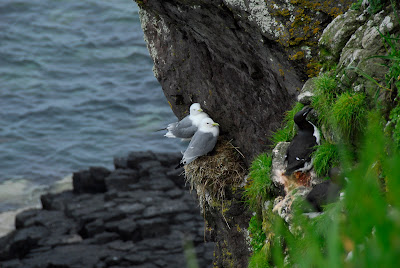 Ever since then, I have been hoping to find one of the several possible species of owls in this region sitting in one of the large trees or using one of the nest boxes. And on occasion, I have tried various owl recordings to see if I could entice one to respond.
Ever since then, I have been hoping to find one of the several possible species of owls in this region sitting in one of the large trees or using one of the nest boxes. And on occasion, I have tried various owl recordings to see if I could entice one to respond.This morning , while all of the adults in the household were sleeping late and I was attending to the oldest granddaughter, I was looking out of the kitchen window to see if the chickadees and/or squirrels were eating sunflower seeds from the feeders that had recently been filled. Shortly after I glanced out, a large bird flew by and landed on a horizontal, moss-covered maple branch. It was a Barred Owl! I ran down the basement to get my telephoto lens for my camera, that I already had in hand. Rather than risk going out on the deck and spooking the owl, I opened the kitchen window, removed the screen, and began taking some pictures. The light was very poor and the camera was telling me that I shouldn't be taking pictures because of the lack of light, but that didn't stop me.
About this this time, the youngest granddaughter - 9 months old - began calling for someone to come and get her out of her crib. Not wanting the others to have to get up quite yet, I went to her room to bring her downstairs with me. But Mom intercepted me so I "reluctantly" handed the baby to her.....and ran down the basement again to get my iPod with bird call recordings. By this time, the owl had left its perch and had flown to another nearby tree. From the back deck, I played a Barred owl call, and almost immediately, the owl flew toward me and then over the house to another perch. I could not locate the bird when I walked around the house so I played the call again. And again, it flew over me to another tree. This happened several times until it landed in a tree near the road where I had some better light - and better luck with the camera. There is something about owls that intrigues me - and many others, so I treasure opportunities to get good images of them. You can't beat a morning shared with young granddaughters and a barred owl!



















































